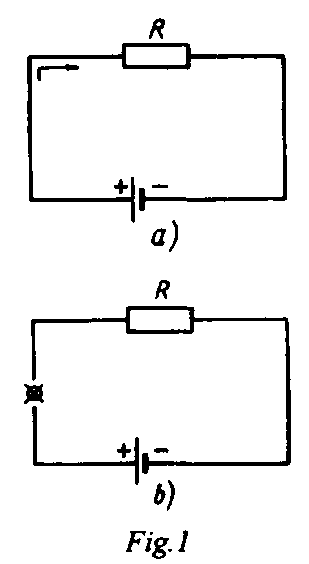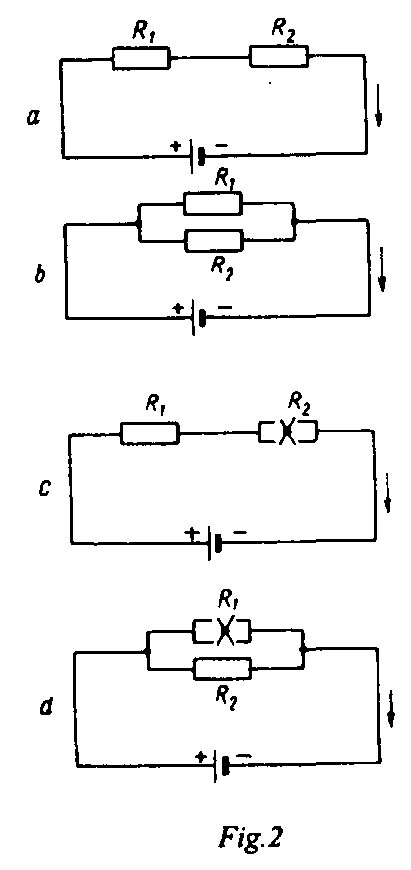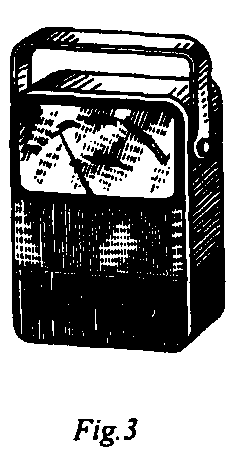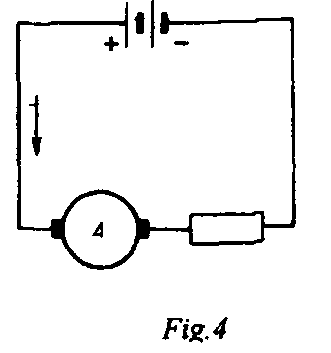
- •1. Electric Circuit. (Unit 5)
- •2. Series Circuit and Parallel Circuit. (Unit 6)
- •3. Meters. (Unit 7)
- •4. Resistor. (Unit 8)
- •5. Electric Cells. (Unit 9)
- •6. Capacitors. (Unit 10)
- •7. Conductors and Insulators. (Unit 11)
- •8. Transformers. (Unit 12)
- •9. Types of Current. (Unit 13)
- •10. Inductance and Mutual Inductance. (Unit 14)
- •11. Coupling . (Unit 15)
1. Electric Circuit. (Unit 5)
This is a circuit. Its elements are a voltage
source, a resistor and a conductor. The circuit consists of a
voltage source, a resistor and conductor. A voltage source supplies
current. A resistor reduces current. A conductor connects the
elements of the circuit. 
Compare circuit a with circuit b. What is the difference between them? Current passes through circuit a while no current passes through circuit b. Circuit b has an open. No current through circuit b results from an open. An open and a short are troubles in a circuit. A trouble in a circuit may result in no current in it.
2. Series Circuit and Parallel Circuit. (Unit 6)
Compare circuits a and b. Circuit a consists of a
voltage source and two resistors. The resistors are connected in
series. Circuit a is a series circuit. Circuit b consists of a
voltage source and two resistors. The resistors are connected in
parallel. Circuit b is a parallel circuit.
A parallel circuit has the main line and parallel branches.
In circuit b the value of voltage in R1 equals the value of voltage in R2. The value of voltage is the same in all the elements of a parallel circuit while the value of current is different. A parallel circuit is used in order to have the same value of voltage.
In circuit a the value of current in R1 equals the value of current in R2. The value of current is the same in all the elements of a series circuit while the value of voltage is different. A series circuit is used in order to have the same value of current. In R1, V1=IR1 is the voltage drop in R1. In R2 the voltage equals IxR2; IR2 is the voltage drop in R2. In circuit c a trouble in one element results in no current in the whole circuit. In circuit d a trouble in one branch results in no current in that branch only, a trouble in the main line results in no current in the whole circuit.
3. Meters. (Unit 7)
Among the most common meters used there are the
ohmmeter, the ammeter and the voltmeter. The ohmmeter is used to
measure the value of resistance. It consists of a milliammeter
calibrated to read in ohms, a battery and resistors. The meter is
connected in parallel and the circuit is not opened when its
resistance is measured. The readings on the scale show the measured
value. 
The ammeter is used to measure the value of
current. When the ammeter is used the circuit should be opened at
one point and the terminals of the meter should be connected to it.
One should take into consideration that the positive terminal of the
meter is connected to the positive terminal of the source the
negative terminal - to the negative terminal of the source. 
The ammeter should be connected in series. The readings on the scale show the measured value.
4. Resistor. (Unit 8)
A resistor is one of the most common elements of any circuit. Resistors are used:
1. to reduce the value of current in the circuit;
2. to produce IR voltage drop and in this way to change the value of the voltage.
When current is passing through a resistor its temperature rises high The higher the value of current the high. The higher the value of current the higher is the temperature of a resistor. Each resistor has a maximum temperature to which it may be heated without a trouble. If the temperature rises higher the resistor gets open and opens the circuit Resistors are rated in watts. The watt is the rate at which electric energy is supplied when a current of one ampere is passing at a potential difference of one volt. A resistor is rated as a l-W resistor if its resistance equals 1,000,000 ohms and its current-carrying capacity equals 1/1,000,000 amp, since P=E x I = IR x I = I2R where P - power is given in watts, R -resistance is given in ohms and I-current is given n amperes. If a resistor has a resistance of only 2 ohms but its current-carrying capacity equals 2,000 amp, it is rated as a 8,000,000-W resistor.
Some resistors have a constant value-these are fixed resistors, the value of other resistors may be varied-these are variable resistors
